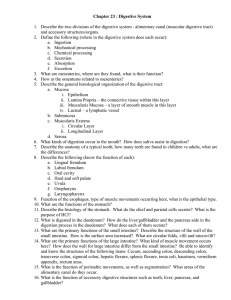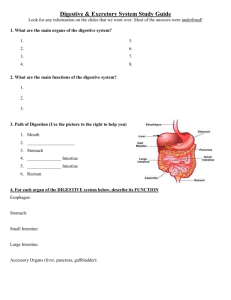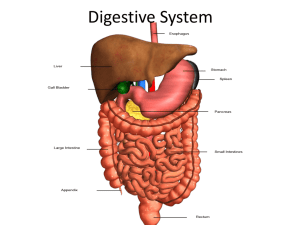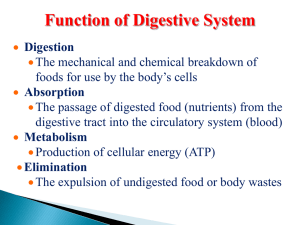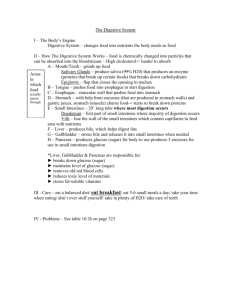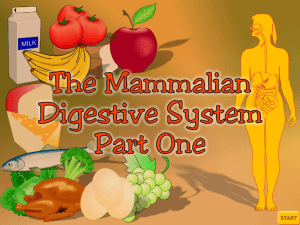The Digestive System
advertisement
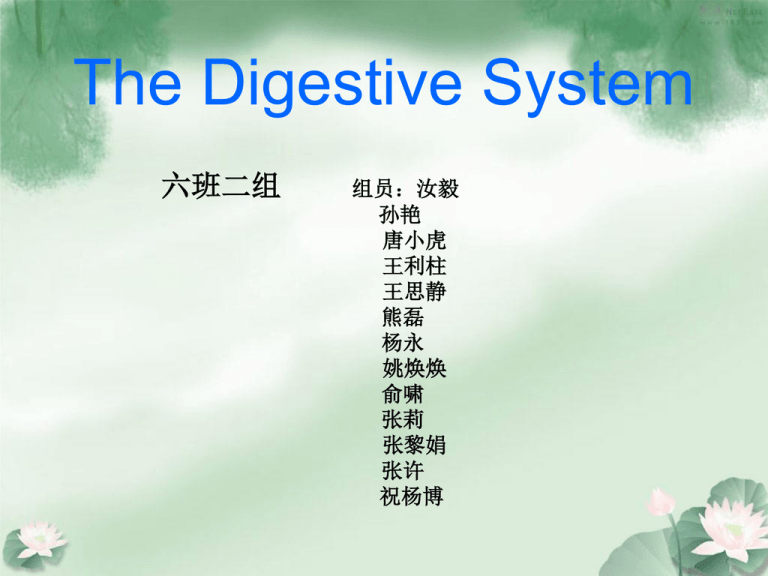
The Digestive System 六班二组 组员:汝毅 孙艳 唐小虎 王利柱 王思静 熊磊 杨永 姚焕焕 俞啸 张莉 张黎娟 张许 祝杨博 Medical terminology • • • • • • • • enter 肠,小肠 duoden /o 十二指肠 jejun /o 空肠 ile/o 回肠 cec/o 盲肠 col/o,colon/o 结肠,肠 sigmoid/o 乙状结肠 proct/o 直肠 • • • • • • Bucc/o Dent/o/I Gingiv/o Lingu/o Or/o Nas/o 颊 牙 牙龈 舌 口 鼻 The Function • Ingestion(摄入):the entry of food • Digestion(消化):the physical and chemical breakdown of food • Absorption(吸收):the passage of these nutrients from the gastrointestinal tract into the bloodstream • Elimination(排泄):the excretion of solid waste materials The Composition The digestive system consists of a 30foot long , mucous membrane-lined tube beginning with the mouth and ending with the ans. It is composed of 9 main organs. 9 main organs • • • • • • • • • Mouth Pharynx(咽) Esophagus(食管) Stomach Small Intestine Large intestine Liver Gallbladder(胆囊) Pancreas(胰腺) The liver , gallbladder , and pancreas are also called accessory organs of the digestive system. 肝,胆,胰,也称为消化系统的附 属器官。 Although food does not pass though these organs , they aid in the processing of food and nutrients. 虽然食物然没有通过这些器官, 但它们会帮助食品和营养物质的处理。 Accessory digestive organs • The liver(肝脏) • The gallbladder(胆囊) • The pancreas(胰腺) The liver function • Produce bile(胆汁) • Manufacture blood proteins • Destroy old erythrocytes and release bilirubin (胆红素) • Remove poison from the blood • Store and release glycogen(糖原) 胆囊和胰腺的作用 • The gallbladder stores bile . When the stomach and duodenum are full , the gallbladder contracts , forcing bile into duodenum. 胆囊储存胆汁。当胃和十二指肠里充满 食物时,胆囊收缩,使胆汁排入十二指肠。 The pancreas manufactures digestive juice containing enzymes that aid in the digestion of proteins , starches and fats. 胰腺制造的消化液中含有的促 进蛋白质,淀粉和脂肪的消化的酶。 The oral cavity Consists of:oral lips(口唇) bucca(颊) palate(腭) teeth tongue salivary gland(唾液腺) The structures within the oral cavity including the teeth, tongue, and palate, are involved in the chewing and swallowing of food. 口腔的结构包括:牙齿,舌头, 和腭。这些结构与咀嚼和吞咽食物有 关。 牙齿 Each tooth consist of nervous and blood vessel, called pulp, surrounded by a hard substance called cementum and a white smooth substance called enamel. 每颗牙齿包含有血管和神经 组成的牙髓,牙髓的周围包裹一 层坚硬的物质叫牙骨质,白色而 光滑的物质是牙釉质。 The tongue is covered with a series of cone-shaped small projection called papillae in which there are taste buds that can sense flavors, such as sweet, bitter, salty, and sour. 舌头上覆盖着许多的锥形凸出物叫做 乳头,它含有的味蕾可以感觉味道,比如 甜味,苦味,咸味和酸味。 The pharynx(咽) and esophagus (食管)serve as passageways for food from mouth to stomach. 咽喉和食管作为食物从口腔到 胃的食物通道。 The stomach can secret hydrochloric(盐 酸)and enzymes which transform food into a semifluid(半流质的)substance called chyme (食糜). 胃可以分泌盐酸和酶,使食物 转化为一种叫做不食糜半流质物质。 The cardiac sphincter relaxes and contract to move food from the esophagus into the stomach, whereas the pyloric sphincter allows food to leave the stomach when it has sufficiently digested . 贲门括约肌通过舒张和收缩将食管中 的食物移入胃,而幽门括约肌则将充分消 化后的食物从胃中排出。 The small intestine ( small bowel ) is the region of the gut where nearly all of the chemical digestion of the nutritional components of food take place. 小肠是消化道中几乎所有的食物中 的营养成分发生化学消化的地方。 The small intestine Including: duodenum(十二指肠) Jejunum(空肠) Ileum(回肠) The large intestine • It is divided into four parts: • Cecum 盲肠 • Colon 结肠 • Sigmoid colon乙状 结肠 • Rectum 直肠 Compared with the small intestine , the large intestine is relatively inactive and has much less functions .Extending from the end of the ileum to the anus. 和小肠相比较,大肠相对来说 较不活泼功能也较少。从回肠末端 延伸至肛门。 Conclusion • Our digestive system kicks in the minute food enters our mouth. • Moving through the digestive tract ,food is chemically broken down into smaller molecules , and nutrients are absorbed into the body. • From here , solid wastes move into the colon , where they remain for a day or two until they are passed out of the body. •Thank you




